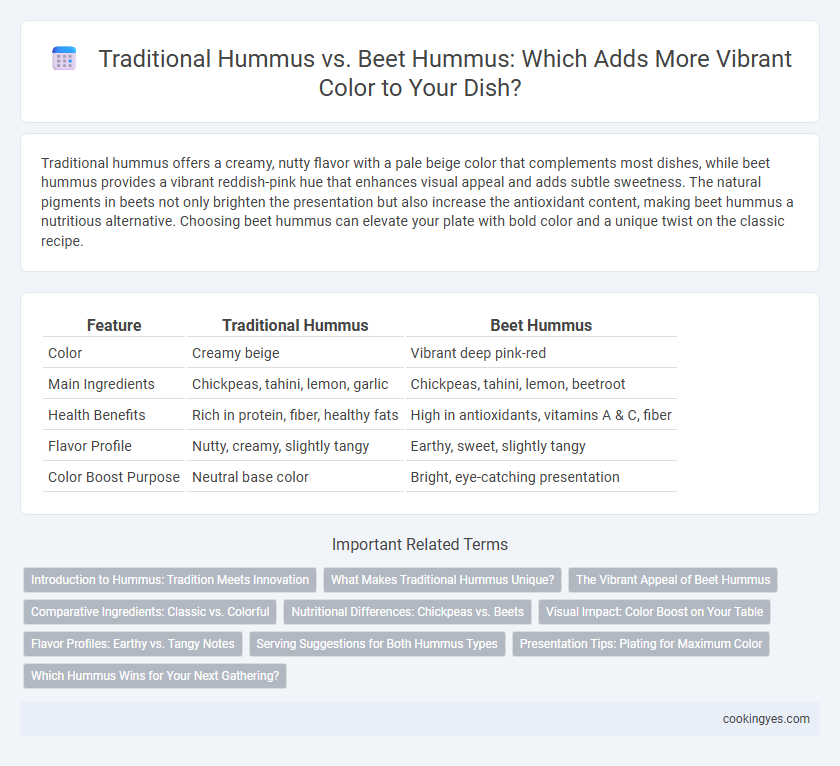Traditional hummus offers a creamy, nutty flavor with a pale beige color that complements most dishes, while beet hummus provides a vibrant reddish-pink hue that enhances visual appeal and adds subtle sweetness. The natural pigments in beets not only brighten the presentation but also increase the antioxidant content, making beet hummus a nutritious alternative. Choosing beet hummus can elevate your plate with bold color and a unique twist on the classic recipe.
Table of Comparison
| Feature | Traditional Hummus | Beet Hummus |
|---|---|---|
| Color | Creamy beige | Vibrant deep pink-red |
| Main Ingredients | Chickpeas, tahini, lemon, garlic | Chickpeas, tahini, lemon, beetroot |
| Health Benefits | Rich in protein, fiber, healthy fats | High in antioxidants, vitamins A & C, fiber |
| Flavor Profile | Nutty, creamy, slightly tangy | Earthy, sweet, slightly tangy |
| Color Boost Purpose | Neutral base color | Bright, eye-catching presentation |
Introduction to Hummus: Tradition Meets Innovation
Traditional hummus, made from blended chickpeas, tahini, lemon juice, and garlic, offers a creamy texture and classic nutty flavor cherished in Middle Eastern cuisine. Beet hummus introduces a vibrant red-purple hue and subtle earthy sweetness while retaining the creamy consistency of traditional recipes. This innovative twist not only enhances visual appeal but also adds nutritional benefits like increased antioxidants and dietary fiber.
What Makes Traditional Hummus Unique?
Traditional hummus stands out with its creamy texture and rich, earthy flavor primarily derived from cooked chickpeas, tahini, lemon juice, and garlic, creating a balanced and wholesome taste. Its pale beige color is a natural result of the main ingredients, offering a classic, familiar appeal that highlights its Middle Eastern heritage. The simplicity and authenticity of traditional hummus make it a versatile dip, while beet hummus provides a vibrant color boost but alters the flavor profile significantly.
The Vibrant Appeal of Beet Hummus
Beet hummus offers a striking vibrant appeal with its deep magenta hue, making it a visually captivating alternative to traditional beige hummus. The natural betalain pigments in beets not only enhance color intensity but also provide antioxidant benefits. This colorful twist transforms any dish into a vibrant presentation while maintaining the creamy texture and protein-rich profile characteristic of classic hummus.
Comparative Ingredients: Classic vs. Colorful
Traditional hummus primarily features chickpeas, tahini, garlic, lemon juice, and olive oil, resulting in a creamy, beige base rich in protein and fiber. Beet hummus incorporates cooked beets, which not only enhance color vibrancy with deep red hues but also add natural sweetness and additional antioxidants like betalains. Comparing these versions highlights nutritional benefits and aesthetic appeal, with beet hummus offering higher vitamin A and C content alongside a striking visual contrast to the classic recipe.
Nutritional Differences: Chickpeas vs. Beets
Traditional hummus, made primarily from chickpeas, offers a rich source of plant-based protein, fiber, and essential minerals like iron and magnesium, supporting muscle health and digestion. Beet hummus incorporates beets, which add antioxidants such as betalains, along with increased vitamin C and folate content, enhancing immune function and cardiovascular health. While both versions provide fiber, the beet-infused variety delivers additional phytonutrients that contribute to its vibrant color and unique health benefits.
Visual Impact: Color Boost on Your Table
Traditional hummus offers a creamy, beige canvas that highlights the rich, nutty flavors of chickpeas and tahini, creating a classic and comforting visual appeal. Beet hummus introduces a vibrant magenta hue, transforming your table with a striking and naturally intensified color boost that elevates presentation and entices guests. The bold, earthy tones of beet hummus not only enhance visual impact but also add a nutritional twist, making it an ideal choice for colorful, health-conscious spreads.
Flavor Profiles: Earthy vs. Tangy Notes
Traditional hummus features a rich, earthy flavor profile derived from chickpeas and tahini, offering a creamy and subtly nutty taste. In contrast, beet hummus provides a vibrant color boost while introducing tangy, sweet undertones from roasted beets that balance the nutty base. Both variations deliver unique taste experiences, with traditional hummus emphasizing warmth and depth, and beet hummus highlighting bright, refreshing notes.
Serving Suggestions for Both Hummus Types
Traditional hummus pairs excellently with warm pita bread, roasted vegetables, and as a creamy base for falafel wraps, enhancing its rich, nutty flavor. Beet hummus offers a vibrant color boost, making it ideal for serving alongside crudites, garnished with fresh herbs, or used as a visually striking spread on sandwiches and toast. Both types benefit from a drizzle of olive oil and a sprinkle of sesame seeds to elevate texture and presentation.
Presentation Tips: Plating for Maximum Color
Traditional hummus offers a creamy beige base that contrasts beautifully with vibrant toppings like paprika or parsley, enhancing visual appeal through classic color combinations. Beet hummus introduces a bold, natural magenta hue that instantly elevates any platter, making it ideal for striking presentations and seasonal themes. For maximum color impact, layer beet hummus alongside traditional hummus, using colorful garnishes such as pomegranate seeds, microgreens, or roasted chickpeas to create a visually dynamic and appetizing display.
Which Hummus Wins for Your Next Gathering?
Traditional hummus offers a classic, creamy texture with a rich, nutty flavor that appeals to a wide range of palates, making it a reliable choice for gatherings. Beet hummus stands out with its vibrant, deep magenta color and slightly sweet, earthy taste that adds both visual appeal and a unique twist to your appetizer spread. For color boost and novelty, beet hummus wins by transforming the usual presentation, while traditional hummus remains a crowd-pleaser for those who prefer familiar flavors.
Traditional hummus vs Beet hummus for color boost Infographic

 cookingyes.com
cookingyes.com